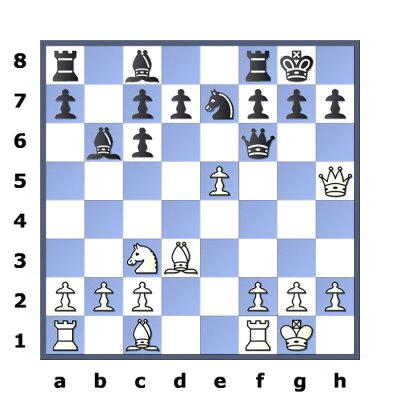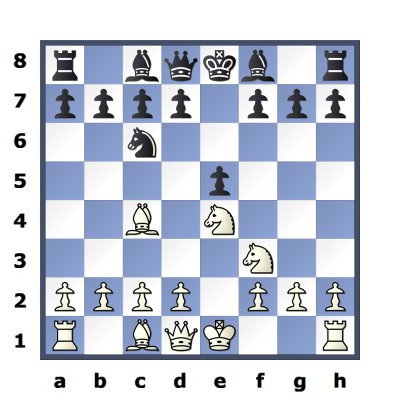Index and Pins --- Skewers --- Double attacks --- Knight forks
Discovered attacks --- Deflection --- Back rank mates
Double attacks: hitting from two directions
Double attacks are when you attack two pieces at once; in most cases your opponent can defend one of those pieces, but not both of them. Here is a simple example.
The basic idea

The White Bishop attacks both Black Rooks at once. Only one of those those Rooks can escape, leaving the other one to be captured.
White has now "won the exchange" - which means winning a Rook for a minor piece (= Bishop or Knight).
Attacking a square

Actually not all double attacks attack pieces; you can also attack critical squares in your opponent's position.
In this position White (though a Rook down) understandably played on, as he was hoping that his d-pawn would prove unstoppable. But Black forced resignation with the move Rc4, which attacks (i) the White Rook and (ii) the square c1.
If the White Rook sidesteps the attack, then the unchallenged Black Rook delivers checkmate on c1, but otherwise the White Rook is lost and the Pawn cannot get to the eighth rank without itself being captured.
Attacking a piece... plus threatening mate
Playing Black, I resigned in this position. White has played Qh5, attacking my loose Bishop on c5. However, the real point of White's play comes if I retreat my Bishop to escape (or defend it any other way. Nothing works). In that case, White would have pushed his e-pawn to e5 (diagram 2) attacking my Queen and simultaneously opening up a threatened mate on h7. A deadly double attack.
Black cannot counter the two threats effectively and will at the very least lose his Knight, leaving him in a hopeless position.


Another threatened mate

The best thing about threatening mate is that your opponent must attend to that immediately, leaving any other threat undefended.
Here, White can play his Queen to g5 threatening (i) mate on g7 and (ii) the capture of the Rook on d8. The mate must be guarded against, and the Rook is history.
Examine all checks and captures

Every book tells you to do this, and you ignore or forget about that advice at your peril.
In this example White fell into one of the oldest traps in the book, and allowed Black's Queen to come to a5 and check his King. This move also carries with it an attack on White's undefended b5 Bishop, and that Bishop will be taken on Black's next move.
Suicidal carelessness from White, and well spotted by my opponent!
Threatened mate once more

A straightforward one. Qc2 threatens a winning attack on h7, and also attacks the Bishop on c6. Game over.
Pawn forks

A special example of double attack is the pawn fork. Here, pushing the d-pawn to d5 attacks both the Bishop and the Knight, and wins one of them.
Pawn forks are very common winning devices.
A well known pawn fork
Diagram 1: it is White to play, and in this position a lot of people rather lazily bring their b1 Knight out to c3. This, however, is an error.
Black can then take the pawn on e4, and when White retakes with his Knight (diagram 2) Black has the resource of advancing his d-pawn to d5, forking the Bishop and the Knight. This does not bring about a winning advantage, but Black has regained the piece and his development is freer than White's. Advantage to Black.
From diagram 1, better moves for White would be d3, Ng5 or d4 (the latter two bringing about quite tricky positions, by the way).


Index and Pins --- Skewers --- Double attacks --- Knight forks --- Discovered attacks --- Deflection --- Back rank mates